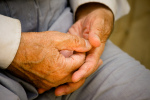
Osteoporosis
Bone benefits of calcium stop when supplementation ends
 Calcium supplements do benefit the bones of older men but the benefits stop after the supplementation ends, says a report published in Osteoporosis International.
Calcium supplements do benefit the bones of older men but the benefits stop after the supplementation ends, says a report published in Osteoporosis International.
Experts looked at data from 322 healthy men to see if the positive effects on bone mineral density of calcium supplements still exists when they stop taking the supplements. Continue reading
People over 85 years not effectively treated for osteoporosis
 People over the age of 85 years are not being treated as effectively for osteoporosis as they need to be, according to a new UK study published in Osteoporosis International.
People over the age of 85 years are not being treated as effectively for osteoporosis as they need to be, according to a new UK study published in Osteoporosis International.
Experts assessed the management of osteoporosis in 739 people who were 85 years old; most were women. They found that 33.7% had one or more fragility fractures, and 332 fractures occurring in these 249 people. Of these, 38% had experienced a fall in the last 12 months. Continue reading
More people surviving hip fracture in the UK due to improved care
 Increasing numbers of people are surviving after hip fracture, says The National Hip Fracture Database 2014 report, and it’s down to better care.
Increasing numbers of people are surviving after hip fracture, says The National Hip Fracture Database 2014 report, and it’s down to better care.
The average 30 day death rate for hip fracture patients in 2013 dropped to 8.05%, improving on the 2011-12 figure of 8.1%. It might sound like a small difference, but it translates to 300 fewer people dying. Continue reading
Questions raised about new joint implants
 Innovations to devices used in joint replacement have been introduced without enough evidence that they are any better than existing implants, suggests a large review published in the British Medical Journal.
Innovations to devices used in joint replacement have been introduced without enough evidence that they are any better than existing implants, suggests a large review published in the British Medical Journal.
A total of 118 studies were included, that involved 15,384 implants in 13,164 people.
The research team was looking for data on modular femoral necks, ceramic-on-ceramic bearings, and uncemented monoblock acetabular cups used in hip replacements, and for gender-specific and high-flexion implants in knee replacements. Continue reading
Hand osteoarthritis and diabetes – new relationships discovered
 Hand pain has been associated with diabetes in people who have one or more joints with central erosions, says research published in Arthritis Care & Research. And a strong association was found between diabetes and the number of hand joints that were tender on palpation (ie when touched), but again only in those with erosive disease.
Hand pain has been associated with diabetes in people who have one or more joints with central erosions, says research published in Arthritis Care & Research. And a strong association was found between diabetes and the number of hand joints that were tender on palpation (ie when touched), but again only in those with erosive disease.
Experts set out to look into hand pain in 530 people (average aged 65 years) with radiographic hand osteoarthritis; 71% were women. They looked at erosive and non-erosive hand osteoarthritis. Continue reading
